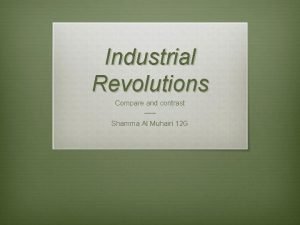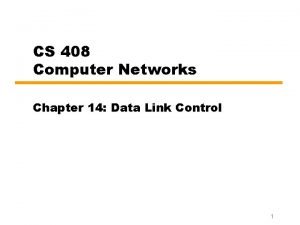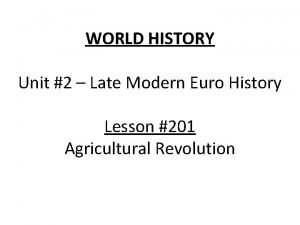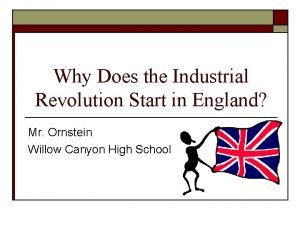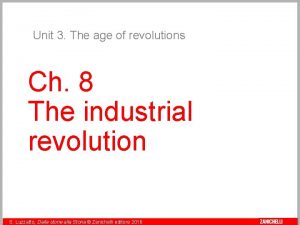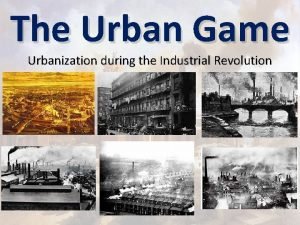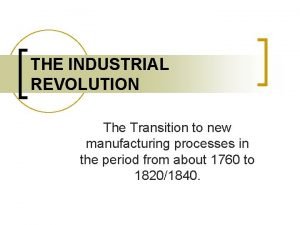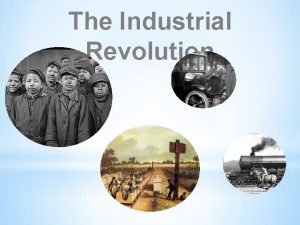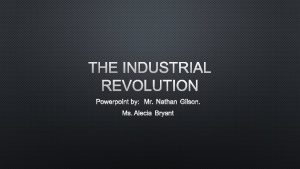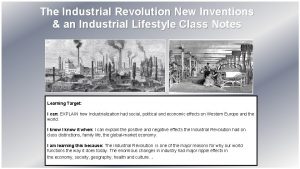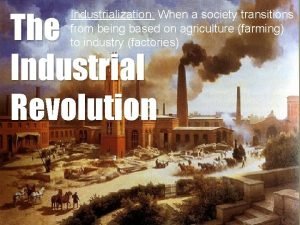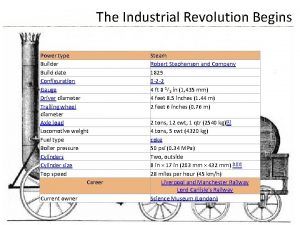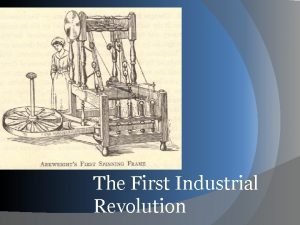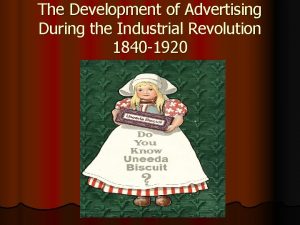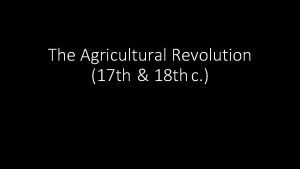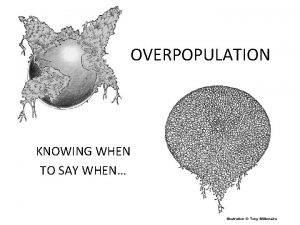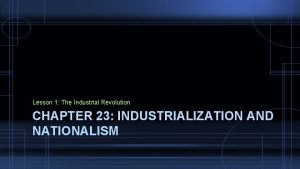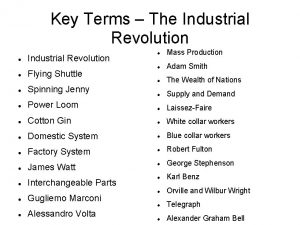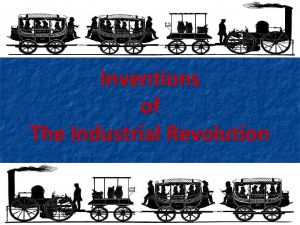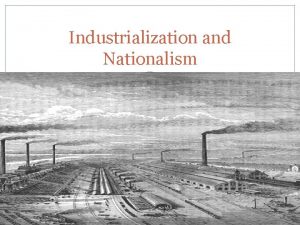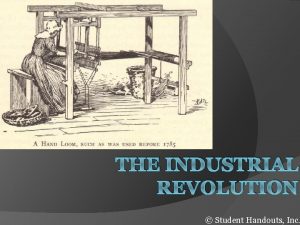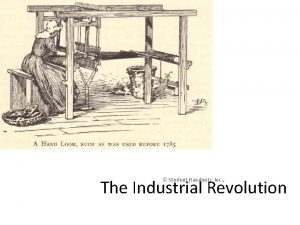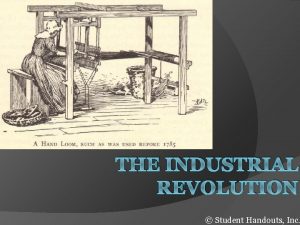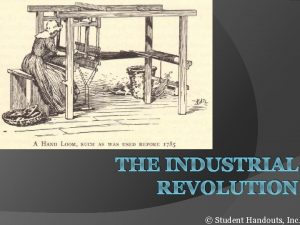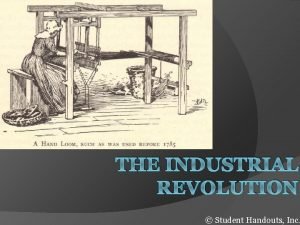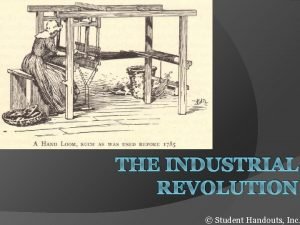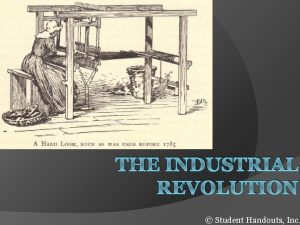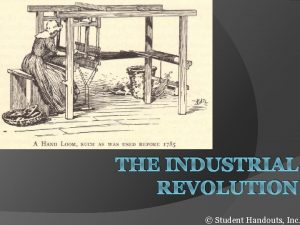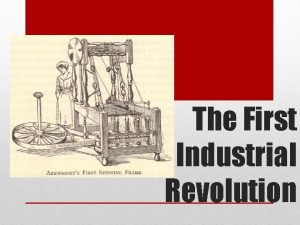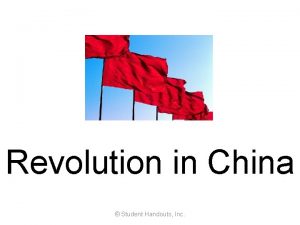THE INDUSTRIAL REVOLUTION Student Handouts Inc THE FIRST






































- Slides: 38

THE INDUSTRIAL REVOLUTION © Student Handouts, Inc.

THE FIRST INDUSTRIAL REVOLUTION

Historical Significance of the Industrial Revolution An ancient Greek or Roman would have been just as comfortable in Europe in 1700 because daily life was not much different – agriculture and technology were not much changed in 2000+ years The Industrial Revolution changed human life drastically More was created in the last 250+ years than in the previous 2500+ years of known human history

What was the Industrial Revolution? The Industrial Revolution was a fundamental change in the way goods were produced, from human labor to machines The more efficient means of production and subsequent higher levels of production triggered far-reaching changes to industrialized societies

The Industrial Revolution Machines were invented which replaced human labor New energy sources were developed to power the new machinery – water, steam, electricity, oil (gas, kerosene) Some historians place advances in atomic, solar, and wind energy at the later stages of the Industrial Revolution Increased use of metals and minerals Aluminum, coal, copper, iron, etc.

The Industrial Revolution Transportation improved Ships ○ Wooden ships → Iron ships → Steel ships ○ Wind-powered sails → Steam-powered boilers Trains Automobiles Communication improved Telegraph Telephone Radio

Developments Mass production of goods Increased numbers of goods Increased diversity of goods produced Development of factory system of production Rural-to-urban migration People left farms to work in cities Development of capitalism Financial capital for continued industrial growth Development and growth of new socio-economic classes Working class, bourgeoisie, and wealthy industrial class Commitment to research and development Investments in new technologies Industrial and governmental interest in promoting invention, the sciences, and overall industrial growth

Background of the Industrial Revolution Commercial Revolution 15 th, 16 th, and 17 th centuries Europeans expanded their power worldwide Increased geographic knowledge Colonies in the Americas and Asia Increased trade and commerce Guild system could not meet the demands of increasing numbers goods

Background of the Industrial Revolution Scientific Revolution 17 th and 18 th centuries Discoveries of Boyle, Lavoisier, Newton, etc. Intellectual Revolution 17 th and 18 th centuries Writings of Locke, Voltaire, etc. Atmosphere of discovery and free intellectual inquiry Greater knowledge of the world Weakened superstition and tradition Encouraged learning and the search for better and newer ways of doing things

Development of the Domestic System of Production Domestic system developed in England Late 1600 s-late 1800 s Domestic system of production Business people delivered raw materials to workers’ homes Workers manufactured goods from these raw materials in their homes (typically articles of clothing) Businesspeople picked up finished goods and paid workers wages based on number of items Domestic system could not keep up with demand

Factory System Developed to replace the domestic system of production Faster method of production Workers concentrated in a set location Production anticipated demand For example: Under the domestic system, a woman might select fabric and have a business person give it to a home-based worker to make into a dress. Under the factory system, the factory owner bought large lots of popular fabrics and had workers create multiple dresses in common sizes, anticipating that women would buy them.


England: Birthplace of the Industrial Revolution No concrete start date for the Industrial Revolution Marked by gradual, slow changes After 1750 – these changes were noticeable first in England

Why the Industrial Revolution Started in England Capital for investing in the means of production Colonies and Markets for manufactured goods Raw materials for production Workers Merchant marine Geography

England’s Resources: Capital The Commercial Revolution made many English merchants very wealthy These merchants had the capital to invest in the factory system – money to buy buildings, machinery, and raw materials

England’s Resources: Colonies and Markets Wealth from the Commercial Revolution spread beyond the merchant class England had more colonies than any other nation Its colonies gave England access to enormous markets and vast amounts of raw materials Colonies had rich textile industries for centuries Many of the natural cloths popular today, such as calico and gingham, were originally created in India China had a silk industry

England’s Resources: Raw Materials England itself possessed the necessary raw materials to create the means of production Coal – vast coal reserves powered steam engines Iron – basic building block of large machines, railroad tracks, trains, and ships

England’s Resources: Workers Serfdom and guilds ended earlier in England than other countries English people could freely travel from the countryside to the cities Enclosure Acts – caused many small farmers to lose their lands, and these former farmers increased the labor supply

England’s Resources: Merchant Marine World’s largest merchant fleet Merchant marine built up from the Commercial Revolution Vast numbers of ships could bring raw materials and finished goods to and from England’s colonies and possessions, as well as to and from other countries

England’s Resources: Geography England is the political center of Great Britain, an island Great Britain (as the entire island was called beginning in 1707) did not suffer fighting on its land during the wars of the 18 th century Island has excellent harbors and ports Damp climate benefited the textile industry (thread did not dry out) Government stable No internal trade barriers

“Necessity Is the Mother of Invention” Spinning machine Need to speed up weaving Power loom created

“Necessity Is the Mother of Invention” Power loom Increased demand for raw cotton Invention of the cotton gin

“Necessity Is the Mother of Invention” Cotton gin Demands for stronger iron Improvements in iron smelting and the development of steel (Bessemer process)

“Necessity Is the Mother of Invention” As more steampowered machines were built, factories needed more coal to create this steam Mining methods improved to meet the demand for more coal • The process of inventing never ends • One invention inevitably leads to improvements upon it and to more inventions

The Textile Industry Textiles – cloths or fabrics First industry to be industrialized Great Britain learned a lot about textiles from India and China

The Birth and Growth of the Textile Industry John Kay (English) Flying shuttle, 1733 Hand-operated machine which increased the speed of weaving James Hargreaves (English) Spinning jenny, 1765 Home-based machine that spun thread 8 times faster than when spun by hand Richard Arkwright (English) Water frame, 1769 Water-powered spinning machine that was too large for use in a home – led to the creation of factories

The Birth and Growth of the Textile Industry Samuel Crompton (English) Spinning mule, 1779 Combined the spinning jenny and the water frame into a single device, increasing the production of fine thread Edward Cartwright (English) Power loom, 1785 Water-powered device that automatically and quickly wove thread into cloth Eli Whitney (American) Cotton gin, 1793 Device separated raw cotton from cotton seeds, increasing the cotton supply while lowering the cost of raw cotton Elias Howe (American) Sewing machine, 1846 Speed of sewing greatly increased

Development of Steam Engines Early water power involved mills built over fast-moving streams and rivers Early water power had problems Not enough rivers to provide the power needed to meet growing demand Rivers and streams might be far removed from raw materials, workers, and markets Rivers are prone to flooding and drying

Steam Power Humans tried harnessing steam power for millennia Hero of Alexandria, Egypt – created a steam -driven device in the 1 st century B. C. E. Thomas Newcomen, England (1704) Created a steam engine to pump water from mines James Watt, Scotland (1769) Improved Newcomen’s engine to power machinery

Steam Engines By 1800, steam engines were replacing water wheels as sources of power for factories Factories relocated near raw materials, workers, and ports Cities grew around the factories built near central England’s coal and iron mines Manchester, Liverpool

Increases in Coal and Iron Production, 1770 -1800 Coal production doubled 6 million to 12 million tons Pig iron production increased 250% 1800 – 130, 000 tons Great Britain produced as much coal and iron as every other country combined

Transportation Increased production Search for more markets and raw materials Before the Industrial Revolution • Canal barges pulled by mules • Ships powered by sails • Horse-drawn wagons, carts, and carriages After the Industrial Revolution • Trains • Steamships • Trolleys • Automobiles Better and faster means of transportation

Transportation Revolution Robert Fulton (American) • Steamboat (1807) • Sped water transportation Thomas Telford and John Mc. Adam (British) • Macadamized roads (18101830) • Improved roads Gottlieb Daimler (German) • Gasoline engine (1885) • Led to the invention of the automobile George Stephenson (English) • Locomotive (1825) • Fast land transport of people and goods Rudolf Diesel (German) • Diesel engine (1892) • Cheaper fuel Orville and Wilbur Wright (American) • Airplane (1903) • Air transport

Communications Revolution Samuel F. B. Morse (American) Alexander Graham Bell (American) • Telegraph (1844) • Rapid communication across continents • Telephone (1876) • Human speech heard across continents Cyrus W. Field (American) • Atlantic cable (1866) • United States and Europe connected by cable Guglielmo Marconi (Italian) Lee de Forest (American) Vladimir Zworykin (American) • Wireless telegraph, an early form of the radio (1895) • No wires needed for sending messages • Radio tube (1907) • Radio broadcasts could be sent around the world • Television (1925) • Simultaneous audio and visual broadcast

Results of the Industrial Revolution Economic Changes • Expansion of world trade • Factory system • Mass production of goods • Industrial capitalism • Increased standard of living • Unemployment Political Changes • Decline of landed aristocracy • Growth and expansion of democracy • Increased government involvement in society • Increased power of industrialized nations • Nationalism and imperialism stimulated • Rise to power of businesspeople Social Changes • Development and growth of cities • Improved status and earning power of women • Increase in leisure time • Population increases • Problems – economic insecurity, increased deadliness of war, urban slums, etc. • Science and research stimulated

Environmental Change The Peppered Moth

Review Questions 1. What was the Industrial Revolution? 2. Describe at least three developments of the Industrial Revolution. 3. Compare and contrast the domestic and factory methods of production. 4. Why did the Industrial Revolution begin in England? 5. Explain why one invention or development leads to another.

Review Questions 6. Explain how developments in the textile industry sparked the Industrial Revolution. 7. Considering the conditions necessary for industrialization to occur, how well equipped is the undeveloped world for becoming industrialized? Are modern undeveloped nations in a better or worse position than 18 th- and 19 th-century England?
 Student handouts inc
Student handouts inc Www.studenthandouts
Www.studenthandouts Student handouts inc
Student handouts inc First and second industrial revolutions
First and second industrial revolutions Zoo103 handouts pdf
Zoo103 handouts pdf Jane schaffer person
Jane schaffer person Slide samples
Slide samples Handout gestalten
Handout gestalten Cs408 handouts
Cs408 handouts Cs408 handouts
Cs408 handouts Definition of handouts
Definition of handouts Gapped handouts
Gapped handouts Advantages and disadvantages of handouts in teaching
Advantages and disadvantages of handouts in teaching Patient education pamphlet template
Patient education pamphlet template Disadvantages of advertising
Disadvantages of advertising Russian revolution vs french revolution
Russian revolution vs french revolution You should hope that this game will be over soon
You should hope that this game will be over soon Third agricultural revolution
Third agricultural revolution Enclosure movement
Enclosure movement Why did the industrial revolution start in britain
Why did the industrial revolution start in britain Industrial revolution zanichelli
Industrial revolution zanichelli The urban game us history
The urban game us history Enclosure movement industrial revolution
Enclosure movement industrial revolution Long term impacts of the industrial revolution
Long term impacts of the industrial revolution Industrial revolution transition
Industrial revolution transition Industrial revolution quiz
Industrial revolution quiz Nathan gilson
Nathan gilson Positive effects of the industrial revolution
Positive effects of the industrial revolution The factory
The factory Enclosure movement definition industrial revolution
Enclosure movement definition industrial revolution 1st industrial revolution
1st industrial revolution Industrial revolution advertising
Industrial revolution advertising Enclosure movement
Enclosure movement 2nd industrial revolution timeline
2nd industrial revolution timeline Thomas malthus industrial revolution
Thomas malthus industrial revolution Lesson 1 the industrial revolution
Lesson 1 the industrial revolution Flying shuttle industrial revolution
Flying shuttle industrial revolution Who invented the phonograph in the industrial revolution
Who invented the phonograph in the industrial revolution Lesson quiz 10-2 industrialization and nationalism answers
Lesson quiz 10-2 industrialization and nationalism answers



